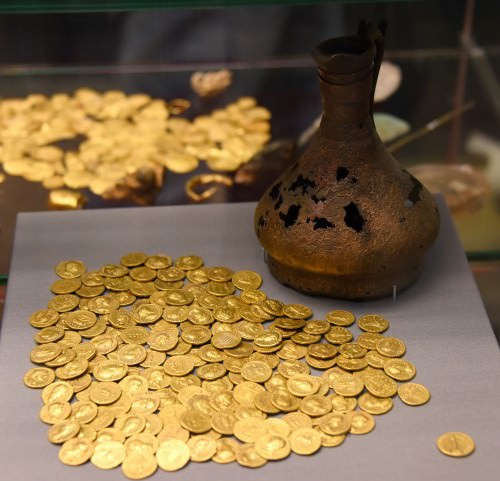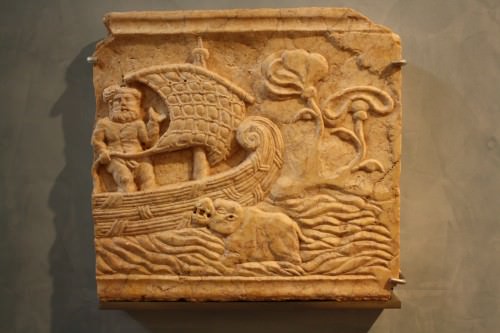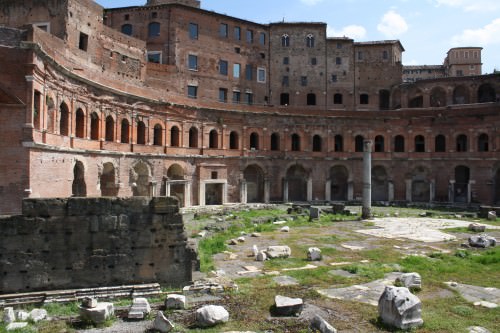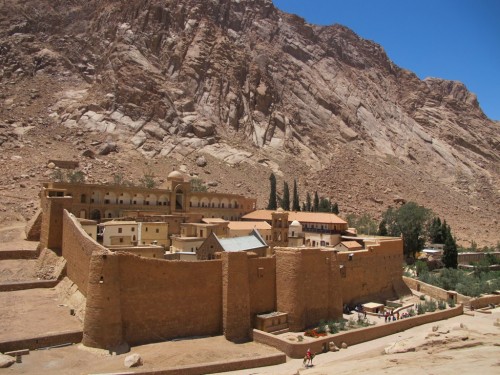Trade in the Roman World › Basil the Great » Origins and History
Articles and Definitions › Contents
- Trade in the Roman World › Ancient History
- Basil the Great › Who Was
Ancient civilizations › Historical places, and their characters
Trade in the Roman World › Ancient History
Ancient Civilizations
Regional, inter-regional and international trade was a common feature of the Roman world. A mix of state control and a free market approach ensured goods produced in one location could be exported far and wide. Cereals, wine and olive oil, in particular, were exported in huge quantities whilst in the other direction came significant imports of precious metals, marble, and spices.

Corbridge Hoard & Jug
FACTORS DRIVING TRADE
Generally speaking, as with earlier and contemporary civilizations, the Romans gradually developed a more sophisticated economy following the creation of an agricultural surplus, population movement and urban growth, territorial expansion, technology innovation, taxation, the spread of coinage, and not insignificantly, the need to feed the great city of Rome itself and supply its huge army wherever it might be on campaign.
The economy in the Roman world displayed features of both underdevelopment and high achievement. Elements of the former, some historians have argued (notably MIFinley), are:
- an over-dependence on agriculture
- a slow diffusion of technology
- the high level of local town consumption rather than regional trade
- a low level of investment in industry.
However, there is also evidence that from the 2nd century BCE to the 2nd century CE there was a significant rise in the proportion of workers involved in the production and services industries and greater trade between regions in essential commodities and manufactured goods. In the later empire period, although trade in the east increased - stimulated by the founding of Constantinople - trade in the western empire declined.
THOSE CITIZENS RICH ENOUGH TO INVEST, OFTEN EMPLOYED SLAVES, FREEDMEN, & AGENTS TO MANAGE THEIR BUSINESS AFFAIRS.
The Roman attitude to trade was somewhat negative, at least from the higher classes. Land ownership and agriculture were highly regarded as a source of wealth and status but commerce and manufacturing were seen as a less noble pursuit for the well-off. However, those rich enough to invest often overcame their scruples and employed slaves, freedmen, and agents ( negotiatores ) to manage their business affairs and reap the often vast rewards of commercial activity.
TRADED GOODS
Whilst the archaeological evidence of trade can sometimes be patchy and misrepresentative, a combination of literary sources, coinage and such unique records as shipwrecks helps to create a clearer picture of just what the Romans traded, in what quantity, and where.
Trade involved foodstuffs (eg olives, fish, meat, cereals, salt, prepared foods such as fish sauce, olive oil, wine and beer ), animal products (eg leather and hides), objects made from wood, glass, or metals, textiles, pottery, and materials for manufacturing and construction such as glass, marble, wood, wool, bricks, gold, silver, copper, and tin. Finally, there was, of course, also the substantial trade in slaves.

Roman Mosaic Showing the Transport of an Elephant
The fact that many goods were produced as regional specialities on often very large estates, for example, wine from Egypt or olive oil from southern Spain, only increased the inter-regional trade of goods. That such large estates could produce a massive surplus for trade is evidenced at archaeological sites across the empire: wine producers in southern France with cellars capable of storing 100,000 litres, an olive oil factory in Libya with 17 presses capable of producing 100,000 litres a year, or gold mines in Spain producing 9,000 kilos of gold a year. Although towns were generally centres of consumption rather than production, there were exceptions where workshops could produce impressive quantities of goods. These 'factories' might have been limited to a maximum workforce of 30 but they were often collected together in extensive industrial zones in the larger cities and harbours, and in the case of ceramics, also in rural areas close to essential raw materials (clay and wood for the kilns).
SOMETIMES TRADE GOODS FOLLOWED LAND ROUTES SUCH AS THE WELL-ESTABLISHED SILK ROAD OR TRAVELLED BY SEA ACROSS THE MEDITERRANEAN & INDIAN OCEANS.
Goods were not only exchanged across the Roman world, however, as bustling ports such as Gades, Ostia, Puteoli, Alexandria, and Antioch also imported goods from such far-flung places as Arabia, India, Southeast Asia, and China.Sometimes these goods followed land routes such as the well-established Silk Road or travelled by sea across the Indian Ocean. Such international trade was not necessarily limited to luxury goods such as pepper, spices (eg cloves, ginger, and cinnamon), coloured marble, silk, perfumes, and ivory, though, as the low-quality pottery found in shipwrecks and geographical spread of terracotta oil lamps illustrates.
TRANSPORTING GOODS
Goods were transported across the Roman world but there were limitations caused by a lack of land transport innovation. The Romans are celebrated for their roads but in fact, it remained much cheaper to transport goods by sea rather than by river or land as the cost ratio was approximately 1:5:28. Nevertheless, it should be remembered that sometimes the means of transport was determined by circumstances and not by choice and all three modes of transport grew significantly in the 1st and 2nd centuries CE.

Ship Relief, Saguntum
Although transport by sea was the cheapest and fastest method (1,000 nautical miles in 9 days) it could also be the riskiest - subject to the whims of weather and theft from piracy - and was restricted by the seasons as the period between November and March (at least) was regarded as being too unpredictable for safe passage.
From the analysis of over 900 shipwrecks from the Roman period the most typical size of merchant vessel had a capacity for 75 tons of goods or 1500 amphorae but there were bigger vessels capable of transporting up to 300 tons of goods. One interesting example is the 40s CE Port Vendres II wreck located in the Mediterranean off the Spanish-French border. The cargo was taken from at least 11 different merchants and contained olive oil, sweet wine, fish sauce, fine pottery, glass, and ingots of tin, copper, and lead.
STATE CONTROL OF TRADE
In the imperial period, there was great state control over trade in order to guarantee supply (the annona system) and even a state merchant fleet, replacing the system during the Republic of paying subsidies ( vecturae ) to encourage private shipowners. There was a specific official in charge of the grain supply (the praefectus annonae ) who regulated the various shipowner associations ( collegia navicularii ). The state taxed the movement of goods between provinces and also controlled many local markets ( nundinae ) - often held once a week - as the establishment of a market by a large land-owner had to be approved by the Senate or emperor.

Trajans Market, Rome
The greatest state expenditure was on the army, which required some 70% of the budget. The state's apparatus of taxation to acquire revenue may be considered a success in that, despite the tax burden, local prosperity and economic growth were not unduly hampered.
Evidence of state control can be seen in the many goods which were stamped or carried markers indicating their origin or manufacturer and in some cases guaranteeing their weight, purity or genuineness. Pottery, amphorae, bricks, glass, metal ingots (important for coinage), tiles, marble and wooden barrels were usually stamped and general goods for transportation carried metal tags or lead seals. These measures helped to control trade, provide product guarantees and prevent fraud.Inscriptions on olive oil amphorae were particularly detailed as they indicated the weight of the vessel empty and of the oil added, the place of production, the name of the merchant transporting them and the names and signatures of the officials who carried out these controls.
Trade was also carried out completely independent from the state, though, and was favoured by the development of banking.Although banking and money-lending generally remained a local affair there are records of merchants taking out a loan in one port and paying it off in another once the goods were delivered and sold on. There is also abundant evidence of a free-trade economy beyond the reaches of the empire and independent of the larger cities and army camps.
CONCLUSION
Whatever the exact economic mechanisms and proportion of state to private enterprise, the scale of trade in the Roman world is hugely impressive and no other pre-industrial society came even close. Such mundane functional items as amphorae or oil lamps were produced in their millions and it has been estimated that in Rome alone the quantity of oil traded was 23,000,000 kilograms per year whilst the city's annual wine consumption was well over 1,000,000 hectolitres, probably nearer 2 million.These kinds of figures would not be seen again until industrialisation swept the developed world long after Roman traders had closed their accounting books and been forgotten by history.
Basil the Great › Who Was
Definition and Origins

Saint Basil (c. 330 - c. 379 CE), also known as Basil the Great and Basil of Caesarea, was a bishop of Caesarea in central Asia Minor who staunchly defended the church against the 4th-century CE heresy of Arianism. Basil's writings on monasticism and theological issues would be hugely influential during his lifetime and in later centuries as the Christian Church developed in the east. The saint, regarded as one of the founders of the Greek Orthodox Church, was also noted for his work helping the poor and his sermons which addressed the imbalances in society.
EARLY LIFE
Basil was born c. 330 CE into an aristocratic family who had a large estate at Ibora on the Pontic-Cappadocian border. He received a thorough education at Nicomedia in Bithynia, northwest Asia Minor, possibly under the tutorship of the famed rhetorician from Antioch, Libanius (dc 393 CE) who was, curiously enough, a staunch defender of paganism. As was relatively common for a young aristocrat's education at the time, Basil was also sent to Athens and Constantinople. It was in Athens that Basil reportedly first began to consider a career in the church, but on his return home, he began his working life as a teacher. Then, in the 350s CE, Basil spent some time in monasteries in Syria and Egypt to learn more about the ascetics there. He wrote of his experience in letters and was impressed with what he saw, as this extract reveals:
I was amazed at the way of life of the ascetics. I marvelled at their willingness to suffer, how fervent they were in prayer, how sparing in sleep, in no way admitting the needs of the body, always keeping to the highest purpose and preserving the goal of the soul, in hunger and thirst, cold and nakedness, not bothered with the body, not even giving it the slightest care, but living as if they had no part with things of the flesh, they showed by deed what it means to sojourn here below but to have citizenship in heaven. (Frazee, 22)
Returning home, once again, Basil began to develop his own take on the ascetic life, inspired chiefly by the Armenian Eustathios of Sebaste (bc 300 CE), and he established his own monastery near Caesarea.
ORTHODOXY V. ARIANISM
Basil is considered one of the three great 4th-century CE “Cappadocian Fathers” in the Eastern Church along with his brother Gregory of Nyssa, a noted philosopher, and Gregory of Nazianzos, a bishop of Constantinople who had joined Basil in his early ascetic experiences. All three stood against Arianism and particularly its chief proponent Eunomios. Regarded as heresy, Arianism was an idea developed by Arius, a presbyter from Alexandria, which posited that since Jesus Christ was created from nothing then he could not be the equal of God. Arius' views were condemned by his own bishop, but the heresy became a powerful movement supported and actively promoted by several emperors. Basil and the two Gregories saw themselves as the defenders of orthodoxy.
BASIL WROTE HIS CONTRA EUNOMIUM WHICH EFFECTIVELY DAMAGED THE REPUTATION OF EUNOMIUS.
Ultimately, Arianism was condemned at the First Ecumenical Council of Nicaea in 325 CE, and the church doctrine was clarified so that Jesus Christ and God were considered homoousios or “of the same substance”. Arius was dismissed as a heretic, however, the issue would not rest, especially when Constantine I (r. 306-337 CE) recalled Arius in 328 CE. To confuse the issue further, the emperor was baptized by an Arian bishop on his deathbed, and his son and successor Constantius II (r. 337-361 CE) was also a supporter of Arianism. The whole issue was discussed again but without resolution at the Council of Serdica c. 343 CE. The next emperor, Julian (361-363 CE), boosted the Arian cause by recalling Eunomios from exile for the second time. Emperor Valens (r. 364-378 CE) continued the imperial support of the heresy and actively persecuted those who held on to the Orthodoxy.
Basil was a persistent opponent of Arianism, and to this end, he attended the 360 CE Council of Constantinople and wrote his Contra Eunomium which effectively damaged the reputation of Eunomius. Basil was made the bishop of Caesarea in Cappadocia in c. 370 CE, although the appointment somehow caused a break in relations with his brother Gregory. Besides theology, Basil was noted at this time for his support of charitable institutions, his own hugely popular hospice, and for the sermons he preached with the then-radical message of social justice. Other non-religious causes Basil was passionate about was his opposition to the division of Cappadocia into two provinces.
Basil continued to work to defend the Orthodoxy, although his celebrated opposition to Valens from 364 CE was perhaps not as unambiguous as some later historians portray. The bishop was known, for example, to have agreed to initiate diplomatic missions in Armenia at the emperor's request. Valens also supported Basil's charity work, and it seems clear that Basil was not as radical as some others in the fight against heresy, but, rather, he took a more conciliatory approach which sought to heal the rift in the church. Further, some of Basil's private letters allude to criticism for not being wholeheartedly orthodox from different quarters, and the bishop was known as a great admirer of Plato. Neither did he dismiss completely some of the ideas in paganism, as shown by his treatise To Young Men, on How They Might Derive Profit from Pagan Literature. Still, the fight against Arianism continued, and the cause was greatly boosted when the imperial tide turned with a new emperor, Theodosius I (r. 379-395 CE), who, unlike his predecessors, was a staunch defender of the Orthodoxy. Theodosios exiled Eunomios, had the Orthodoxy affirmed in a decree of 380 CE and then had Arianism condemned once again in the 381 CE Council of Constantinople.

St. Catherine's Monastery, Sinai
INFLUENCE ON MONASTICISM
A writer of many theological works, Basil famously helped develop the concept of the Trinity in church doctrine, categorically stated that the taking of human life under any circumstances was a sin, and proposed that prayers to icons were permissible as they were thus passed on to the figure portrayed in them. He created an influential regime for monks which balanced work and worship, the Basilian rule, which would greatly define Byzantine monasticism for centuries thereafter. Basil's guidelines for monks and nuns and thoughts in general for the wider Christian community were set out in his Long and Short Rules. Basil promoted cenobitic monasticism, that is that monks should not simply be cloistered away but take an active part in the life of the community, helping the needy and spreading God's word. This is clearly stated in Basil's rule 3:
Who is unaware that man is a peace-loving and sociable animal, and not a solitary and wild one? For nothing is so characteristic of our nature as to associate with one another, to need one another, and to love our own kind?(Frazee, 28)
Basil also stressed that monasteries should ensure that their monks work together for common goals and that the monastery achieve economic self-sufficiency through working its own land. Benedict of Nursia, the famous ascetic, was said to have been inspired by the writings of Basil on these topics and Byzantine monasticism, in general, owes a great debt to Basil. In addition to his theological works, many of the letters which Basil wrote to friends and officials survive and are an invaluable insight into the general history of the period and provincial life especially.
DEATH
Unfortunately, Basil did not live to see the final triumph of Orthodoxy, the traditional date of his death being held 1 January 379 CE. However, some scholars prefer an earlier date sometime in 377 CE. Made a saint for his life works, Basil remains a complex and somewhat controversial figure, with church scholars continuing to insist on his wholehearted orthodoxy while secular scholars tend to be more sceptical. Saint Basil's influence on monasticism, though, remains undisputed, and he still stands as one of the most important figures in medieval Christianity and the Eastern Orthodox Church.
LICENSE:
Article based on information obtained from these sources:with permission from the Website Ancient History Encyclopedia
Content is available under License Creative Commons: Attribution-NonCommercial-ShareAlike 3.0 Unported. CC-BY-NC-SA License